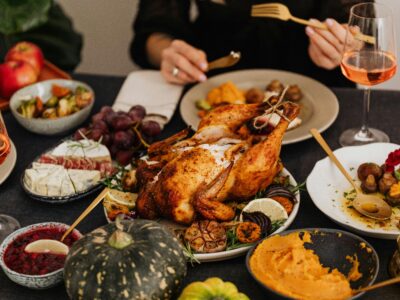
Thanksgiving is a day for gratitude, reflection and gathering with loved ones around a shared meal.
But in the United States, where about 30% of the food supply turns into food waste, according to the USDA, this holiday has also become synonymous with overindulgence—and the waste that comes with it.
How do we celebrate together while limiting our impact on the environment (and without breaking the bank)? This year, let’s focus on creating a more sustainable and enjoyable holiday we can all be thankful for.
You can get a head start on your resolutions by following some of the suggestions below.
Choose your turkey with intention
Organic? Free-range? Pasture-raised? It can be overwhelming to choose a turkey these days, but the first step to Thanksgiving shopping should be understanding what these labels mean.
While the exact parameters of “organic,” free-range and “pasture-raised” labels may vary, here are some general rules to keep in mind: An organic turkey has been raised on organic feed with no antibiotics. A free-range turkey had access to outdoor space at some point in their lifecycle. You can look for labels like USDA Organic and Animal Welfare Approved to identify these more sustainable birds. On the other hand, pasture-raised is a largely unregulated term, so you will need to look to the individual farm for more information.
If there is a farmers’ market near you, consider looking for heritage breeds. This moniker means the turkeys were allowed to breed and grow on their own, living out their natural life cycles.
Although buying local is generally better for the environment, farmers may not use any of the aforementioned labels. Instead, try to get to know the local farmers and learn about their raising practices. Once you find a farm you trust, you can build a years-long relationship.
Consider an alternative main dish
Maybe you’ve been thinking about reducing your meat eating. Or you want to get a little more adventurous with your cooking and put some pandemic culinary skills into practice. Or perhaps you simply want to save some time and money this year. Why not try some turkey alternatives?
You can choose a plant-based option, like Tofurkey or Field Roast-brand Celebration Roast. And instead of using turkey juice as your gravy base, you can opt for mushrooms.
Or if you really can’t live without meat, try substituting for smaller, sustainably raised Cornish hens or a chicken and start a new holiday tradition.
Don’t make side dishes an afterthought
Sides can be just as memorable as the main course if you get creative! Make delicious and filling dishes by including as many beans and legumes as you can—they are healthy, sustainable, inexpensive and tasty. For example, incorporate chickpeas (or garbanzo beans), black beans and green peas into your feast. Instead of rice—whose cultivation produces methane responsible for around 1.5 percent of total greenhouse gas emissions—try another grain like couscous, quinoa and millets mixed with nuts, cranberries and kale.
If you can buy organic, do it. While it depends on the product and the store, sometimes the price will not be much higher. You can also save money and reduce plastic waste by choosing whole vegetables over pre-cut options.
And don’t be afraid of canned or frozen veggies or cranberries. Just look for low-sodium and no added sugar options.
Pace yourself
It’s easy to get swept up with preparing as much food as possible for your holiday meal. But remember to be realistic about what you and your guests can reasonably consume. Food waste emits methane gas when it ends up in our landfills; plan for your meal and leftovers so you won’t be throwing things out that are still viable to eat. Or try to compost what cannot be saved.
Portion out the meal ahead of time. Of course RSVPs can change at the last minute, but try to estimate how many people are coming and get the serving sizes right. You can use a tool like the Guest-imator to help.
And if you’ve outdone yourself, make the most of leftovers!
Speaking of planning, before Thanksgiving Day, make room in your fridge and freezer by eating what is already there. After the meal, you’ll likely have lots of leftovers so make sure you have somewhere to put them!
Remember that bones, leftover vegetable scraps like carrot peels, kale stems and onion skins can all be used to make delicious soup stocks.
Try to move toward glass storage containers to minimize plastic use. But if you do get take-out food before the holiday, save any containers for sending home leftovers with your guests. And finally, ask your guests to bring their own reusable containers so no food goes to waste.
Do you have other ideas for a more eco-friendly Thanksgiving? Share them in the comments below!
Jessica Fanzo is a professor of climate and director of the Food for Humanity Initiative at the Columbia Climate School. Her research focuses on the transdisciplinary field of food systems and the linkages between agriculture, health and the environment in climate-impacted countries that have limited resources.




We always get the smallest turkey available, around 10 pounds. It is enough for the meal with some leftovers to make other dishes, like turkey enchiladas or turkey soup.
We don’t do Thanksgiving here in Australia. The size of a turkey is something to consider. Suitable for a very big family only.